In the land of milk and honey, California is home to an astonishing variety of birds. From the bald eagles that call the state “home” to the red-winged blackbirds that call total darkness “shelter,” this is one of the most popular states to spend your vacation in. And owls are always having a ball in California.
The state has some of the most beautiful and even more remote places in which to spend a summer holiday. More than 20 counties in California have no other residents but owls, where it’s a perfect way to celebrate their season as they lay their eggs and enjoy the cool pines, orchards, and forests where they hatch from their eggs.
California is home to many owls, some of which are only found in California. Here are some of the most common species you can find here:
1. Western Screech Owl

- Kingdom: Animalia
- Phylum: Chordata
- Class: Aves
- Order: Strigiformes
- Genus: Megascops
- Species: Megascops kennicottii
The Western screech owl (Megascops kennicottii) is a large owl found in Canada and the Western United States. They are gray with white patches and have long tails. The male has a typical screech owl look with its huge eyes, long beak, and enormous wingspan. Their diet consists of small mammals, like chipmunks, rabbits, and squirrels, yet they may also eat birds, such as doves or hawks. If they find them first!
These owls screech, not hoot, in California. They build their nests in tree cavities or on cliffs where there’s enough space for them to rear their young ones without being disturbed by predators or humans trying to steal eggs from nests outside your house.

2. Short-Eared Owl
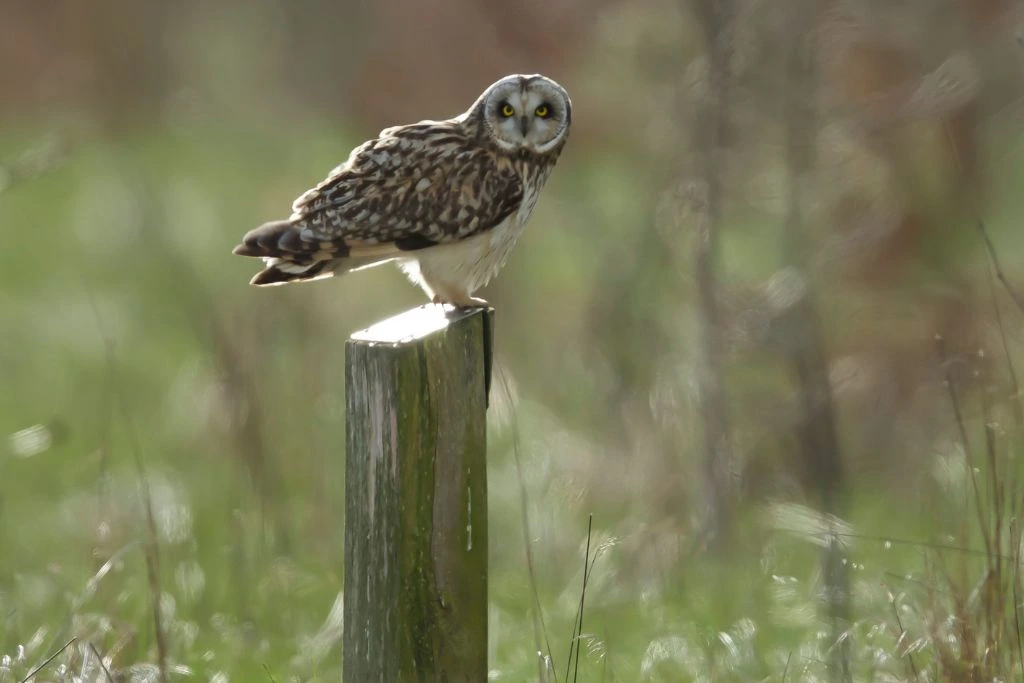
- Kingdom: Animalia
- Phylum: Chordata
- Class: Aves
- Order: Strigiformes
- Genus: Asio
- Species: Asio flammeus
The short-eared owl (Asio flammeus) is a large species with a body length of about 35 cm, a wingspan of about 70 cm, and weighs about 2.2 lbs. It has distinctive ear tufts that stand up like spikes. The plumage is dark brown, with lighter undersides and white patches on its face, throat, and breast.
The short-eared owl mainly eats small mammals, such as mice, shrews, and voles. It also consumes insects, such as grasshoppers, when available in abundance during the summer. They can catch small birds, like sparrows or starlings, in flight or at night when searching for prey. They will also eat carrion if available, but only sometimes take advantage of other food sources, such as fruit trees. This is due to the time they need between meals to eat all their food before the next meal arrives.

3. Northern Saw-Whet Owl
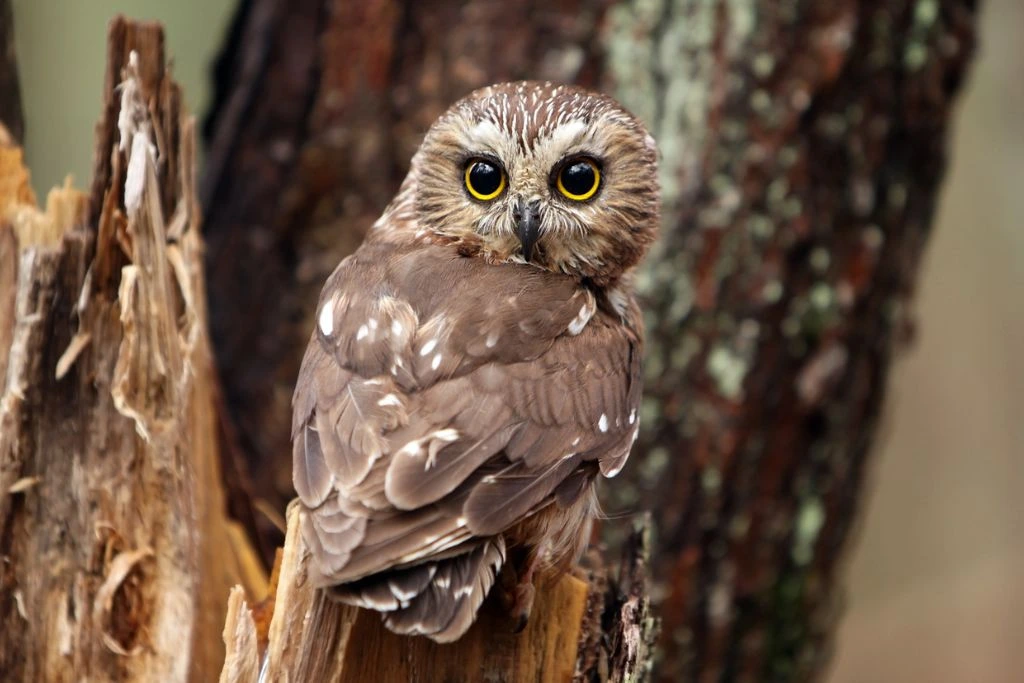
- Kingdom: Animalia
- Phylum: Chordata
- Class: Aves
- Order: Strigiformes
- Genus: Asio
- Species: Asio flammeus
The northern saw-whet owl (Aegolius acadicus) is a small, gray-brown bird with black spots on its wings and tail. It has a prominent white V on its forehead, which is where it gets its name from (the “saw” refers to the shape of this V).
The northern saw-whet owl can be found throughout much of North America, except for parts of Mexico and Central America (note: it does not live in South America). They prefer wooded areas near water sources, such as wetlands or riversides.
They are a nocturnal bird, which means it is mostly active at night. It hunts for small mammals, like mice and voles, although it will also eat insects and other animals if given a chance. These owls are monogamous during the mating season, forming bonds with one partner for life.
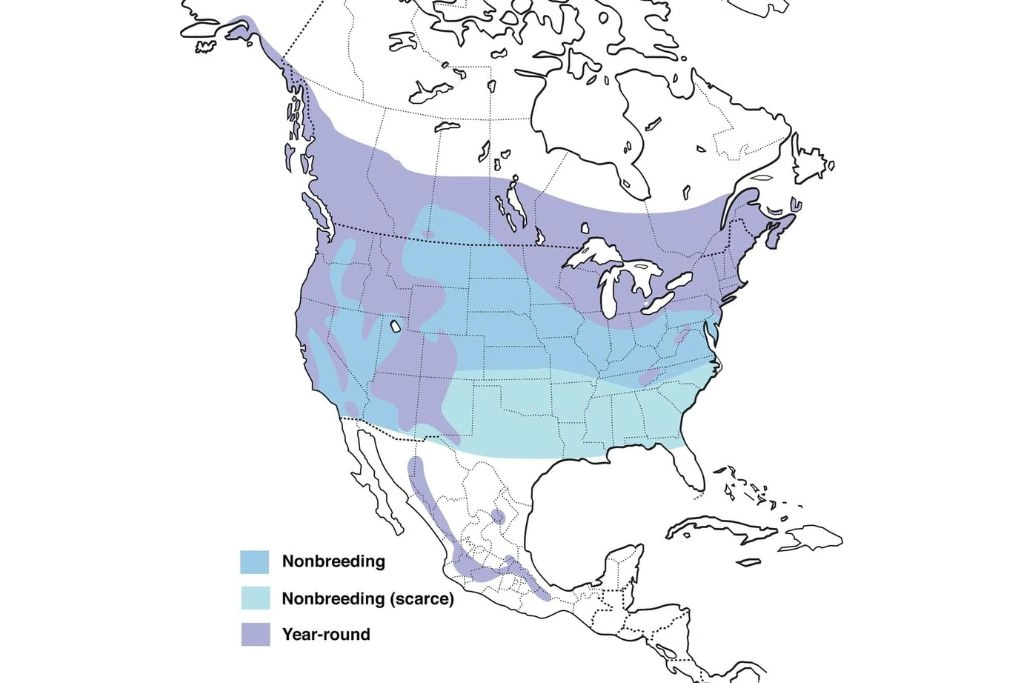
4. Barn Owl

- Kingdom: Animalia
- Phylum: Chordata
- Class: Aves
- Order: Strigiformes
- Genus: Tyto
- Species: Tyto alba
Barn owls (Tyto alba) are the most common owls in central California, with over 20 different subspecies found in the state. Other states with large populations include Arizona, Colorado, and New Mexico. They hunt primarily at night but may also forage during the day if food is abundant enough to find it.
The barn owl’s diet consists mainly of rodents, such as mice and rats. However, they will also eat birds when available. Barn owls have been known to hunt on their own or with other members of their family group. They wait for prey to become more active during daylight hours, but they often prefer nocturnal hunting because it gives them more time alone with their prey.
Barn owls are also one of the most common owl species in California and are found throughout the state. They prefer to live near open fields, farmland, and grassland habitats, but can also be found living in cities if they have access to large buildings with holes that allow them to enter into attics or basements.
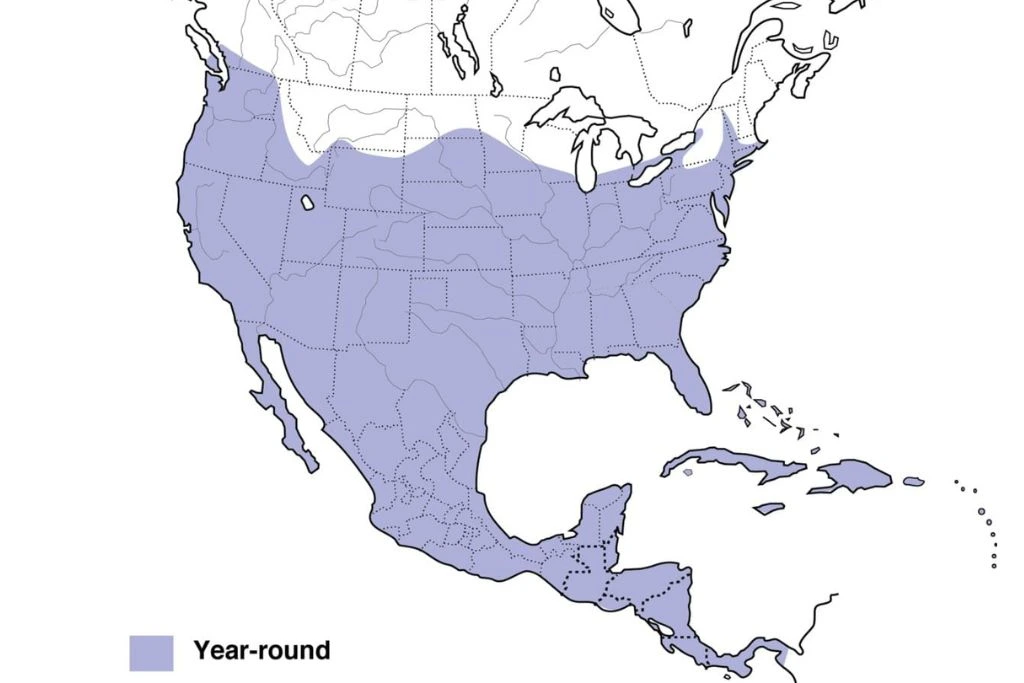
5. Great Horned Owl

- Kingdom: Animalia
- Phylum: Chordata
- Class: Aves
- Order: Strigiformes
- Genus: Bubo
- Species: Bubo virginianus
The great horned owls (Bubo virginianus) are large owls in Southern California that are a white-feathered birds with black heads and faces. They have yellow eyes and large feathers on their wings and tail that can be raised into an intimidating display when threatened.
The great horned owl eats mainly small mammals, such as mice, rats, squirrels, rabbits, and other rodents. They also consume carrion, insects, fish, eggs from ground-nesting birds or bats, fruits/vegetables, and small reptiles when available. This owl has long, sharp talons and a hooked beak that is perfect for tearing into prey.
It is nocturnal, or active at night. During the day, it may be found roosting in trees but can also be seen perched on fence posts and poles, hunting for prey. The great horned owl has excellent hearing and eyesight that allows it to spot prey from distances of up to 100 feet away.

6. Burrowing Owl

- Kingdom: Animalia
- Phylum: Chordata
- Class: Aves
- Order: Strigiformes
- Genus: Athene
- Species: Athene cunicularia
Burrowing owls (Athene cunicularia) are small owls in California that live in the desert and grasslands. They have a long tail, short wings, and a large head with a prominent ear tuft. The eyes are dark brown or black, with white rings around them. All burrowing owls have feathers on their feet that allow them to dig through dirt for food or shelter during hibernation season (November through April).
Burrowing Owls eat small mammals, such as mice, squirrels, and rats, but also consume carrion when needed, like insects or other invertebrates. They rarely capture live prey. They can be found throughout California but prefer areas with sandy soil where they may hide during daylight hours.

7. Northern Pygmy Owl

- Kingdom: Animalia
- Phylum: Chordata
- Class: Aves
- Order: Strigiformes
- Genus: Glaucidium
- Species: Glaucidium californicum
The northern pygmy owl (Glaucidium californicum) is a tiny owl found throughout the Pacific Northwest, California, and Baja, California. It has a distinctive call and prefers to remain in trees or forested areas. In large groups of up to 10 individuals, these owls will often chase down other birds for food or fly around searching for prey (usually small rodents).
This species also likes to nest near water sources, such as lakes or rivers, because it needs access to fresh water for breeding purposes.

8. Snowy Owl

- Kingdom: Animalia
- Phylum: Chordata
- Class: Aves
- Order: Strigiformes
- Genus: Bubo
- Species: Bubo scandiacus
The snowy owl (Bubo scandiacus) is a large bird that lives in the Arctic tundra and subarctic regions of the northern hemisphere. They live throughout the Americas, but their range is limited to Canada, Alaska, and the northern parts of Siberia.
These white owls in California eat fish, small birds, and mammals, such as lemmings or voles (small rodents). They also scavenge on carrion if nothing else is available to them. These owls live in groups called “flocks,” which sometimes number up to 20 individuals.

9. Barred Owl

- Kingdom: Animalia
- Phylum: Chordata
- Class: Aves
- Order: Strigiformes
- Genus: Strix
- Species: Strix varia
Barred owls (Strix varia) belong to the most common owls in Northern California. They are nocturnal and can be found in forests, swamps, and wetlands.
Barred owls eat rodents, like mice, voles, shrews, and lemmings. They also eat beetles, grasshoppers, and other insects they find on their prey during the day.
They have been spotted in Northern California for many years, but only recently did we begin to see them regularly enough, and people started noticing them more often.

10. Long-Eared Owl

- Kingdom: Animalia
- Phylum: Chordata
- Class: Aves
- Order: Strigiformes
- Genus: Asio
- Species: Asio otus
The long-eared owl (Asio otus) is a large owl that lives in open areas. It has long ears and a tufted tail, which helps it to stay warm during cold nights.
They eat small mammals, like mice and voles, but can also eat other birds’ eggs or fish if available.

11. Northern Spotted Owl

- Kingdom: Animalia
- Phylum: Chordata
- Class: Aves
- Order: Strigiformes
- Genus: Strix
- Species: Strix occidentalis caurina
The northern spotted owl (Strix occidentalis caurina) is the largest owl in California and one of the most significant owls in North America. It has a wingspan between 4 and 5 feet long, making it more prominent than any other bird in California.
It lives in coniferous forests with large trees, such as Douglas fir and Ponderosa pine. It eats many mammals, birds, insects, and amphibians, but prefers mice over other prey because they are easier for it to catch on its own. The female lays two eggs per season (April/May) after mating with her mate during winter. It lives for about ten years.
Northern spotted owls are a threatened species. The species is protected by the US Fish and Wildlife Service, which lists it as one of the endangered species. In 1998, California became the first state to list this owl as a threatened species under its laws.

12. Great Gray Owl

- Kingdom: Animalia
- Phylum: Chordata
- Class: Aves
- Order: Strigiformes
- Genus: Strix
- Species: Strix nebulosa
The great gray owl (Strix nebulosa) is considered the largest owl in North America and has a wingspan of 6 feet. They have yellow eyes and are found in Canada and the Northern United States. The great gray owl is nocturnal, which means they hunt at night.
They are excellent hunters and use their hearing, sight, and sense of smell to find their prey. They can also hear prey under the snow because the ground vibrates when small mammals move around. They eat small mammals, birds, and reptiles.
The great gray owl lives in forests with lots of trees and cliffs so that they can build a nest on top of them. They are tranquil birds, but they do make some noises. They make a series of hoots and yelps.

13. Flammulated Owl

- Kingdom: Animalia
- Phylum: Chordata
- Class: Aves
- Order: Strigiformes
- Genus: Psiloscops
- Species: Psiloscops flammeolus
The flammulated owl (Psiloscops flammeolus) is a small owl found in California, Oregon, and Washington. It’s also one of the most endangered birds in North America.
The flammulated owl eats insects, such as beetles, ants, and grasshoppers primarily. They can be seen at night, flying through trees, looking for food, or sitting on branches during the day, resting before flying off again to find more insects to eat!
Flammulated owls belong to the group of the smallest owls in North America. They can grow about 8 inches long from head to tail, with a wingspan of 13 to -14 inches. Their body is covered with brownish-gray feathers, and their eyes are yellow.

14. Elf Owl

- Kingdom: Animalia
- Phylum: Chordata
- Class: Aves
- Order: Strigiformes
- Genus: Micrathene
- Species: Micrathene whitneyi
The elf owl (Micrathene whitneyi) is the smallest owl species in North America. It prefers coniferous forests but can be found throughout much of Canada and the Northwestern US. They have a wingspan of about 9 inches with a body length of 3 to 4 inches and weigh about 1/3 ounce, or 6 grams, on average.
Elf owls are often seen around open areas, like fields, parks, and golf courses, where they hunt small rodents, like voles, mice, and shrews, at night.
The elf owl is one of the smallest owl species in North America. It is often confused with a hawk or hummingbird when seen flying overhead because it is so tiny. They have a wingspan of about 3.5 inches with a body length of 2 to 3 inches and weigh about an ounce, or 28 grams, on average.
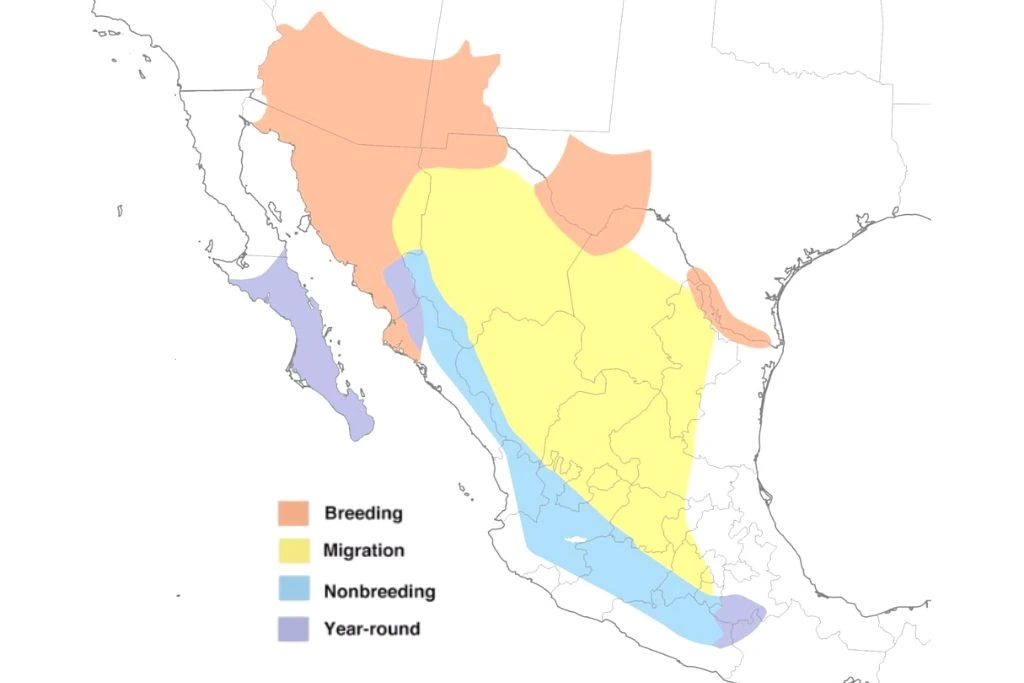
California: Home to Several Types of Owls
You can find several types of owls in California. These birds are nocturnal, so they are rarely seen during the day. Some of these owl species are endangered and need your help!
Owls are nocturnal creatures who hunt at night and eat small rodents, insects, and other animals, like bats. They have excellent eyesight and hearing to help them detect prey in the dark. Owls are all over the world, but they prefer temperate regions because it’s easier for them to find food during winter when there’s less rainfall, which can reduce vegetation.
There are many different species of owls. Some are larger than others, and some prefer to live in forests instead of open spaces. They all have similar body features, like large eyes, soft feathers, sharp beaks, and talons that help them hunt at night.
The owls we’ve talked about today are just scratching the surface of the fascinating world of California owls. There are many more, and they’re all waiting for you to discover them!





